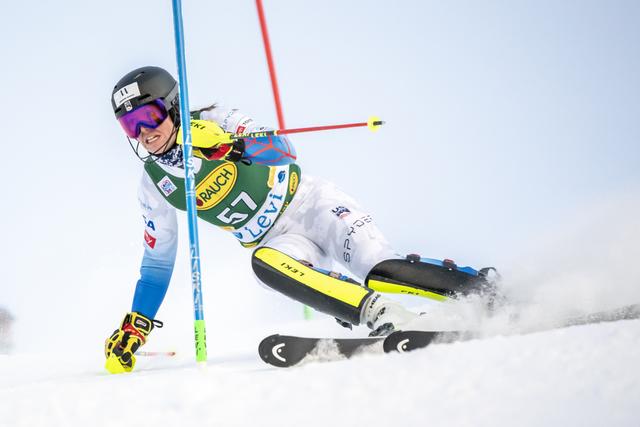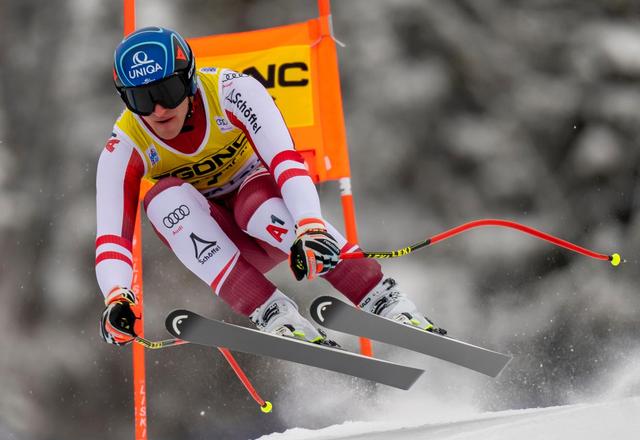03:25
Introduction of alpine skiing rules. Video source: BOCOG (03:24) [Editor’s note]
Beijing Winter Olympics has entered the final countdown of 30 days, and China Olympic athletes are ready to set off, waiting for the decisive moment.
So how much do you know about the competitive events of the Winter Olympics? On this occasion, The Paper has launched the column "Winter Olympics, Do You Know?", which brings a panoramic analysis of the popular science of the Winter Olympics and helps you easily understand the ice and snow doorways.

Alpine skiing is gradually formed on the basis of cross-country skiing and is a branch of snow sports. Since 1936, alpine skiing has been listed as an event in the Winter Olympics, which has quickly attracted the attention of global winter sports enthusiasts for its ornamental and challenging nature.As the host, China has already qualified for 10 events of alpine skiing in the Beijing Winter Olympics. At present, only the women’s super slalom event needs to be continued.

Project introductionAlpine skiing is known as "the jewel in the crown of the Winter Olympics" and is one of the most ornamental competitions.
The competition is a snow racing sport with skis, snowshoes, fixers and ski pole as the main equipment, which slides down from mountain to mountain and along the track set by Qimen.
Alpine skiing in the Olympic Games includes men’s events, women’s events and mixed events. Among them, men’s events and women’s events have five events: downhill, slalom, giant slalom, super giant slalom and all-around, while the mixed events are mixed team events.
Among them, downhill and super giant slalom are speed events, and the ranking is determined according to the result of one slide. Slewing and giant slalom are technical events, which are calculated by the total results of two taxiways.
The alpine skiing competition of Beijing Winter Olympics was held at the National Alpine Ski Center, which produced 11 gold medals. Austria, Switzerland, Norway and other European countries are powerful alpine skiing countries.

gameIn the alpine skiing competition, the rules require the contestants to glide through the marked flag gate in zigzag and slide down the slope at an ultra-fast speed.
Players need to cross a series of flag gates on the taxiing route while sliding down. If a player misses a flag gate, he must go back and cross the missed flag gate again, otherwise he will lose the qualification.
In each event of alpine skiing, a single person starts, and the starting order is determined by drawing lots, but some events need to ski twice, and the order of the second starting is determined by the results of the first competition.
At the time of departure, athletes must wear sportswear with official seal marks (that is, clothes checked and approved by referees), starting number cloth, helmet, snowboard and ski pole, and at the same time, they must use detachable fixers.
The difference between alpine skiing events mainly lies in the different height difference between the starting and ending points of the venue, the different requirements of terrain and slope, and the different methods and numbers of flag gates.
The height difference between the starting point and the end point of the downhill field is 800-1000m for men and 500-700m for women. The length of the line should ensure that the best performance of men is not less than 2 minutes and that of women is not less than 1 minute and 40 seconds in the Winter Olympics and World Championships.
The venue for the slalom should be built on a hillside with a slope of 20 -27 degrees. The width of the venue shall not be less than 40m, and the height difference between the starting point and the ending point is 140m-220m for men and 120m-180m for women. There are 55-75 flag gates for men and 45-60 for women.
The giant slalom venue is usually sloping and wavy, with a width of at least 30 meters. The height difference between the starting point and the finishing point is 350-400 meters for men and 260-350 meters for women. The number of flag gates should be 12-15% of the height difference.
The mixed team race is a parallel race with giant slalom flag gates. The track is 250-300 meters, and the gate spacing is longer than the slalom, but shorter than the slalom.

Historical originAlpine skiing originated in the Alps, so it is also called "alpine skiing". Alpine skiing is gradually formed on the basis of cross-country skiing and is a branch of snow sports.
It is generally believed that alpine skiing was born in 1907, when the first alpine skiing organization "Alpine Ski Club" was founded.
Since the 1920s, alpine skiing competitions have been held in the Alps, and various alpine skiing schools have been established. Since 1936, alpine skiing has been listed as an event in the Winter Olympics.
At first, only men and women were all-around (cancelled in 1952 and restored in 1988). In 1948, men’s and women’s downhill and slalom were added, and in 1952, men’s and women’s giant slalom was added. By 1988, it had increased to 10 events including men’s and women’s super slalom.

China legionAt the ice and snow media meeting in China on December 24th, Liu Zhen, the leader of the alpine skiing national training team, described the project the team was engaged in with "the sport of the brave".
Although China has a weak foundation in alpine skiing, it has achieved great-leap-forward development under the encouragement of the Beijing Winter Olympics. According to Liu Zhen, in the 11 events of alpine skiing, the China team has won 10 events. Next, China athletes will try their best to get the qualification in the women’s super slalom qualifying competition, so as to achieve the small goal of participating in all events of the Beijing Olympic Games.
Affected by the epidemic, the players will not be able to participate in international competitions in 2020, and they will fall behind in the points of Winter Olympics. Since February, 2021, China Alpine Ski Training Team has been catching up by participating in the International Snow Federation Points Tournament held in Xiaohaituo, Yanqing and Yabuli, Heilongjiang.
On August 21st last year, a group of 21 people from China Alpine Ski Training Team came to Austria from Beijing, and continued to challenge the Olympic qualifications. So far, they have obtained the qualifications for 10 events.
Athletes are also actively striving for the only women’s super slalom that has not qualified for the Beijing Winter Olympics. At present, two athletes have scored 82 points and 85 points in a single game respectively; In the next competition, as long as the athletes score 77 points and 74 points respectively, they will be qualified for the women’s super giant slalom.
According to the schedule, the men’s team left for home last month and entered the closed training base of Chongli. The women’s team will participate in the last week’s competition in Europe from January 10 to 14, and return to China on the 16th, and go directly to Yanqing to prepare for the sprint.
(This article is from The Paper, please download the "The Paper" APP for more original information)
Reporting/feedback
关于作者